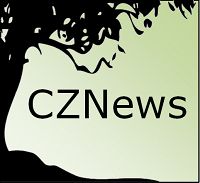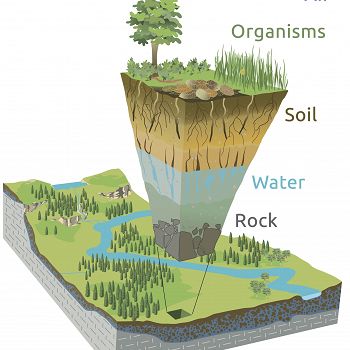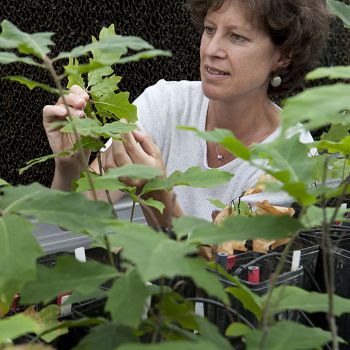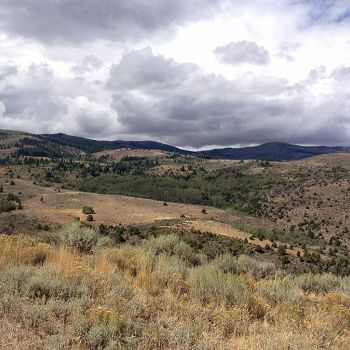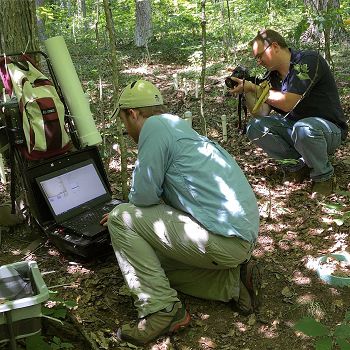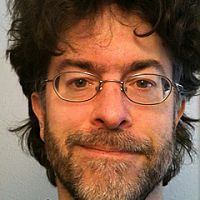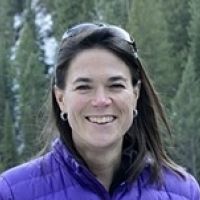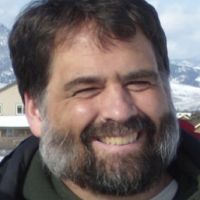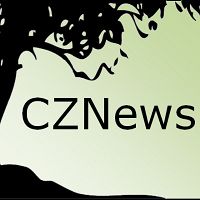CZNews: Summer 2016
Print Verison: CZNews - Summer 2016 (1 MB PDF)
Dr. Susan Brantley receives the Wollaston Medal
The CZO National Office would like to acknowledge and congratulate Dr. Susan Brantley, Lead-PI of the Susquehanna-Shale Hills CZO, Professor of Geosciences at The Pennsylvania State University, and member of the U.S. National Academy of Sciences, on receiving the 2016 Wollaston Medal from the Geological Society of London (GSL). The Wollaston Medal, the highest award given by the Society, recognizes geologists who have had a significant influence on the field through a substantial body of impactful research. Brantley has published over 200 scientific papers contributing to a wide-range of disciplines. Her work spans from observations and modeling at the atomic scale, to laboratory studies of mineral dissolution rates, to field studies of detailed processes, and integrated field studies of whole catchments. Brantley’s notable dedication and contribution to science shows through the reach of her work, her leadership, mentorship of students, and as a role model for women-- being the 2nd woman to receive the award in its 185 year history. The award also recognizes her ability to manage and organize science through her role in the establishment of our CZO network. We appreciate all of Brantley’s effort to explore and understand the processes of the deep CZ, and look forward to continued success in her career. The full citation given by the GSL can be found here.
Improving CriticalZone.org to meet a growing Network
The CriticalZone.org website and associated social media have become important, central hubs of information for the CZ science community. As CZO grows, these online resources need to be adapted and improved for a wider range of participants. The CZO Website Committee (Justin Richardson, Michelle Gilmore, Don Duggan-Haas, Kathleen Lohse, and David Lubinski) is identifying ways that online resources can help improve communication, integrate the CZO Network, and expand its reach. One key strategic adjustment is to expand from a focus on scientists to broader communication with educators and the general public. Related changes thus far include starting the blog “Adventures in the Critical Zone” and the CZO Instagram account @Criticalzoneorg. Another strategic adjustment is to employ a wider range of online tools. For example, online collaboration spaces were set up for some cross-CZO groups using commercial software (Basecamp). Specific plans for improving website functionality include adding a within-website search engine this summer and reducing duplicate information. Another upcoming change will be a new homepage layout, with better introductory content and greater integration of observatories. The committee seeks feedback and participation with all such website changes. Please contact the CZO Webmaster David Lubinski (david.lubinski@colorado.edu) with any comments and suggestions.
Reynolds Creek CZO site visit
On September 19-21, the Reynolds Creek CZO will host a site visit for a PI and co-I from each CZO as well as NSF program officers. During the first day, attendees will discuss the state of network activities such as data management, international CZ efforts, education and outreach, and the CZO website. The day will end with an introduction to the ongoing projects at Reynolds Creek. The second day will be spent touring the Reynolds Creek Watershed, stopping at multiple sites including soil pits, instrument stations, Reynolds Mountain and Upper Sheep Creek. Stops will be led by RCCZO investigators and students to discuss topics such as inorganic carbon, soil carbon modeling and mapping, geophysics, organic matter dynamics, microbial response to freeze-thaw and other current research. On the last day PIs will meet to prepare for the network review by NSF set to occur mid-November, and discuss potential network projects.
Events
- IML CZO Modeling Institute: August 16-19, Urbana, Illinois
- International Symposium on Microbial Ecology: August 21-26, Montreal, Canada
- CZO Fall site meeting: September 19-21, Reynolds Creek CZO, ID
- Slope Aspect Workshop: September 29–October 1, Tucson, AZ
- CZO network review: November 2016, Arlington, VA
CZO Spotlight: The self-organization of river channels
The same section of the Mameyes River showing normal and flood states. A tree is marked for reference.
Luquillo CZO investigators, Colin Phillips (UMn) and Doug Jerolmack (UPenn), published “Self-organization of river channels as a critical filter on climate signals” in the May 2016 issue of Science. The authors found that for rivers with gravel and larger-sized particles, erosion due to intense rainfall is less than expected due to a regulation mechanism within the river. Studying the Mameyes River in northeastern Puerto Rico, rainfall events strong enough to move cobbles occurred about 20 times per year. The heaviest of these rainfalls could increase the river discharge 100-fold, but moved tracers within cobbles only moderately farther than a more typical rain. USGS data from 186 rivers were analyzed to confirm that flows exceeding the threshold of motion were rare. Authors reason that the width and depth of river channels adjust to keep the forces of water flow near the threshold of motion, the force required to move particles on the riverbed. With climate change expected to increase rainfall, these findings will relate the effects of climate change to landscape evolution.
CZO Education & Outreach Update
The CZO education & outreach committee, led by Don Duggan-Haas and Robert Ross (CZO NO), has recently worked to increase awareness and use of CZ science. The committee worked together on a CZ-themed issue of the journal, The Earth Scientist, of the National Earth Science Teacher Association (NESTA). CZO researchers and educators contributed a series of articles towards secondary Earth science classrooms for an upcoming issue, currently in external review. During July, Duggan-Haas presented a CZO poster at the 2nd annual Earth Educators' Rendezvous in Madison, WI, one of the largest gatherings of Earth science educators in North America. He also presented a workshop on CZ science at the New York Earth Science Teachers Association's Annual Geologic Field Conference. The National Office (NO) is working with a PBS station, WSKG in Binghamton, NY, to create several short videos (about 3 to 5 minutes) about CZ science that can be hosted on PBS LearningMedia where Earth and environmental science teachers can access the videos, associated content and lesson plans. Expected to be completed over the course of about a year, the videos will be accessible via YouTube and possibly played in other PBS contexts. At the Paleontological Research Institute’s Teacher Resource Day on October 1, talks will be given related to CZ science and the development of the videos by the NO’s Justin Richardson and WSKG's Nancy Coddington, respectively. An abstract was submitted on CZ science in education for the Geological Society of America meeting in Denver in September. Various CZ science presentations are lined up for the Science Teacher Association of New York State annual conference in November and the Pennsylvania Science Teachers Association conference in December.
CZO REU/RET 2016
This summer, 13 undergraduates and three teachers are involved in CZ research at the Susquehanna Shale Hills CZO and Stroud Water Research Center (SWRC) as part of NSF’s Research Experiences for Undergraduates (REU) and Teachers (RET) program. Students participated in a six-day orientation beginning at Penn State to learn about the Shale Hills CZO catchment in relation to the Valley and Ridge physiographic province. Participants explored the regional sedimentary geology, connected vegetation to the Earth’s litho-, hydro-, atmo-, and bio- spheres, and collected stream discharge data and samples throughout the greater Shaver’s Creek Watershed. The group then traveled to SWRC located in the Piedmont physiographic province to learn about data collection and management, the programming of Arduinos, hydrologic influence on landscape evolution, and the role of macro-invertebrates in stream health. Orientation was wrapped up with a trip to the Serpentine Barrens at Nottingham County Park, a unique environment of the Critical Zone. Now working with CZO scientists and graduate students, participants will present their research at the upcoming CUAHSI Biennial Symposium poster session on Monday, July 25th.
CZNews
Receive the CZO Email Newsletter
Occasional email will include news, events, and other info related to Critical Zone Observatories.
We hate spam as much as you do, so your information will never be shared. You can unsubscribe at any time.
Dr. Susan Brantley (Penn State)
View of Reynolds Creek CZO
The same section of the Mameyes River showing normal and flood states. A tree is marked for reference.
WSKG interviewing a Shale Hills graduate student.
REUs Leila and Uma along with CZO RET Lauren (right) looking at macroinvertabrates at the Stroud Water Research Center.
Beth Hoagland (PSU) showing REUs Bryan, Taylor and Uma how to collect stream data at Shale Hill's sandstone site Garner Run.
The Critical Zone. Illustration modified from Chorover, J., R. Kretzschmar, F. Garcia-Pichel, and D. L. Sparks. 2007. Soil biogeochemical processes in the critical zone. Elements 3, 321-326. (artwork by R. Kindlimann).
CZO Instagram
News Category:
PEOPLE |
AWARD |
EDUCATION/OUTREACH
People Involved
CZO
-
National, Eel, Luquillo, Shale Hills, INVESTIGATOR, COLLABORATOR
-
National, STAFF
-
Reynolds, INVESTIGATOR
-
National, INVESTIGATOR, STAFF
-
National, INVESTIGATOR, STAFF
-
Sierra, STAFF
-
National, INVESTIGATOR, STAFF
Explore Further
